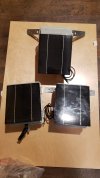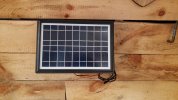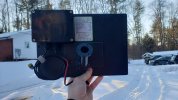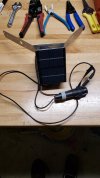wolfpack412
A good 3 year old buck
I've been busy creating a bunch of different solar panels. Figured I'd post some pictures for ideas for anyone tired of spending $$$ on Lithiums or for anyone else like me that dreams of never having to visit your cell cam again if you didn't want to.

20W panel on Spartan GoLive with charge controller mounted in its own box and 2 SLAs. This is way over kill and the battery has only been below 13V once and that was when the solar panel had a foot of snow on it.

10W Panel on Spypoint Cell Link and GardePro E5. One 12V7Ah SLA and charge controller. The clear lid seemed like a good idea at the time. I have another with a 12V18Ah battery as well with a regular lid.

I've been putting these on my Spypoint Micros. They are a 6W with 2SLAs. It is direct wired with a diode to stop back charging. The panel is a little flimsy feeling mounted like this. The Rev2 is below.
 This is the same box with 2 SLAs and a 5W direct wire with a diode. Well, two are this and one has a small junction box with 10 rechargeable AAs. Close up of that is below.
This is the same box with 2 SLAs and a 5W direct wire with a diode. Well, two are this and one has a small junction box with 10 rechargeable AAs. Close up of that is below.

For the one below I have been running a 6V and a 12V of these. The 6V is used on Spartan GoCams the 12V on Spypoint Micros. It has a built in charge controller. Inside the boxes there are 10 rechargeable AAs.



Last is a miniature version I built with a 2W panel and 10 rechargeable AAs. I've tested in on a Micro. I put it out with 80% charge and with it taking about 5-10 pictures a day and being in moderate sunlight it recharged to 100% in 2 days. That little black thing was a voltage meter I put on it to see how well it worked.



20W panel on Spartan GoLive with charge controller mounted in its own box and 2 SLAs. This is way over kill and the battery has only been below 13V once and that was when the solar panel had a foot of snow on it.

10W Panel on Spypoint Cell Link and GardePro E5. One 12V7Ah SLA and charge controller. The clear lid seemed like a good idea at the time. I have another with a 12V18Ah battery as well with a regular lid.

I've been putting these on my Spypoint Micros. They are a 6W with 2SLAs. It is direct wired with a diode to stop back charging. The panel is a little flimsy feeling mounted like this. The Rev2 is below.
 This is the same box with 2 SLAs and a 5W direct wire with a diode. Well, two are this and one has a small junction box with 10 rechargeable AAs. Close up of that is below.
This is the same box with 2 SLAs and a 5W direct wire with a diode. Well, two are this and one has a small junction box with 10 rechargeable AAs. Close up of that is below.
For the one below I have been running a 6V and a 12V of these. The 6V is used on Spartan GoCams the 12V on Spypoint Micros. It has a built in charge controller. Inside the boxes there are 10 rechargeable AAs.



Last is a miniature version I built with a 2W panel and 10 rechargeable AAs. I've tested in on a Micro. I put it out with 80% charge and with it taking about 5-10 pictures a day and being in moderate sunlight it recharged to 100% in 2 days. That little black thing was a voltage meter I put on it to see how well it worked.


